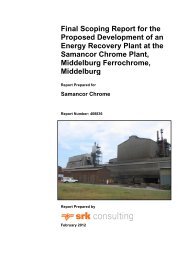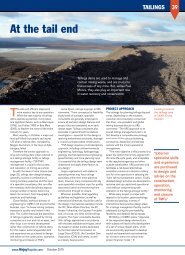Draft Status Quo Report for the Pixley Ka Seme ... - SRK Consulting
Draft Status Quo Report for the Pixley Ka Seme ... - SRK Consulting
Draft Status Quo Report for the Pixley Ka Seme ... - SRK Consulting
You also want an ePaper? Increase the reach of your titles
YUMPU automatically turns print PDFs into web optimized ePapers that Google loves.
<strong>SRK</strong> <strong>Consulting</strong> in association with BKS<br />
<strong>Pixley</strong> <strong>Ka</strong> <strong>Seme</strong> Local Municipality EMF – <strong>Draft</strong> <strong>Status</strong> <strong>Quo</strong> <strong>Report</strong> Page 4<br />
Public participation in <strong>the</strong> air quality management<br />
process and public access to in<strong>for</strong>mation, including<br />
in<strong>for</strong>mation on environmentally harmful practices will<br />
be a crucial component of future legislation. It is<br />
recognised that <strong>the</strong> integration of public participation<br />
into <strong>the</strong> decision-making process will be enhanced<br />
through education and awareness programmes aimed at<br />
<strong>the</strong> empowerment of communities.<br />
Emphasis is to be placed on <strong>the</strong> integration of air<br />
quality issues into <strong>the</strong> transportation, housing and land<br />
use planning processes in order to ensure that air quality<br />
issues are addressed in <strong>the</strong> long term.<br />
Under <strong>the</strong> AQA local authorities are held responsible<br />
<strong>for</strong> air quality management planning. The<br />
decentralisation of air quality management has enabled<br />
management strategies aimed at securing ambient<br />
standards to be geared towards local environments.<br />
Decentralised air quality management is also more<br />
conducive to effective public participation in <strong>the</strong><br />
management process. In decentralised air quality<br />
management, caution is however needed to ensure a<br />
basis <strong>for</strong> effective air quality management, in terms of<br />
expertise, funds, and <strong>the</strong> consistent implementation of<br />
tools.<br />
Priority areas<br />
By notice in <strong>the</strong> government gazette <strong>the</strong> Minister may<br />
declare an area a priority area (PA) if <strong>the</strong> minister or<br />
member of executive council (MEC) reasonably<br />
believes that ambient air quality standards are/may be<br />
exceeded in an area, and specific management actions<br />
need to be implemented in order to rectify <strong>the</strong> situation.<br />
An area may be prioritised if it is considered that it is or<br />
may be impacting on <strong>the</strong> air quality of neighbouring<br />
countries, or if it affects <strong>the</strong> national interest. The<br />
MECs of two or more adjoining Provinces may by joint<br />
action declare an area falling within those Provinces a<br />
PA. Once an area has been declared a PA, an air quality<br />
management plan needs to be prepared and submitted to<br />
<strong>the</strong> relevant authority within <strong>the</strong> timeframe specified by<br />
that authority. Be<strong>for</strong>e approval of <strong>the</strong> plan a<br />
consultative process needs to be followed. The plan<br />
must aim to co-ordinate air quality management in <strong>the</strong><br />
area, address issues related to air quality and provide <strong>for</strong><br />
<strong>the</strong> implementation of <strong>the</strong> plan by a committee. The<br />
committee appointed should be representative of <strong>the</strong><br />
relevant role players.<br />
During <strong>the</strong> writing of this report only two air quality<br />
PAs had been declared under <strong>the</strong> AQA, namely <strong>the</strong><br />
Vaal Triangle and Highveld Priority Area (HPA), with<br />
PKSLM falling within <strong>the</strong> HPA. An air quality<br />
management plan is still under development <strong>for</strong> this<br />
area, with monitoring of key pollutants being<br />
undertaken within GSDM to in<strong>for</strong>m <strong>the</strong> development of<br />
intervention strategies aimed at reducing ambient<br />
pollution levels in <strong>the</strong> region.<br />
1.4.6 National Environmental<br />
Management: Waste Management<br />
Act (Act No. 59 of 2008)<br />
This Act was established to re<strong>for</strong>m <strong>the</strong> laws regulating<br />
waste management in order to protect <strong>the</strong> health and <strong>the</strong><br />
environment by implementing reasonable measures <strong>for</strong><br />
<strong>the</strong> prevention of pollution and ecological degradation<br />
and <strong>for</strong> ensuring sustainable development. It aims to<br />
establish national standards <strong>for</strong> <strong>the</strong> regulation of waste<br />
by all levels of government, provide <strong>for</strong> control of all<br />
waste management activities and implement<br />
remediation measures and compliance en<strong>for</strong>cement <strong>for</strong><br />
land which has been impacted by waste.<br />
1.4.7 National Water Act (Act No. 36 of<br />
1998)<br />
The national importance of water and <strong>the</strong> provision<br />
<strong>the</strong>reof has been acknowledged in <strong>the</strong> Constitution as a<br />
basic human right. The aim of <strong>the</strong> National Water Act<br />
(Act No. 36 of 1998) (NWA) is to ensure that <strong>the</strong> water<br />
resources are protected, used, developed, conserved and<br />
controlled by all reasonable measures. The NWA deals<br />
with <strong>the</strong> development of strategies to facilitate <strong>the</strong><br />
proper management of water resources, provides <strong>for</strong> <strong>the</strong><br />
protection of water resources, regulation of water use<br />
and o<strong>the</strong>r matters relating <strong>the</strong>reto.<br />
Water use is defined to incorporate surface and<br />
groundwater, and includes <strong>the</strong> act of taking water from<br />
a water resource, storing water, impeding or diverting<br />
<strong>the</strong> flow of a water course, engaging in stream flow<br />
reduction activities, discharging water containing waste<br />
or water that has been heated in an industrial process,<br />
altering <strong>the</strong> physical structure or character of a water<br />
course or removing, discharging or disposing of<br />
underground water <strong>for</strong> safety purposes.<br />
KILI/BEAT G:\404946_PIXLEY EMF\7REPORTS\<strong>Status</strong> <strong>Quo</strong> report\<strong>Draft</strong> report\<strong>Draft</strong> status quo report, July 2010.docx July 2010









